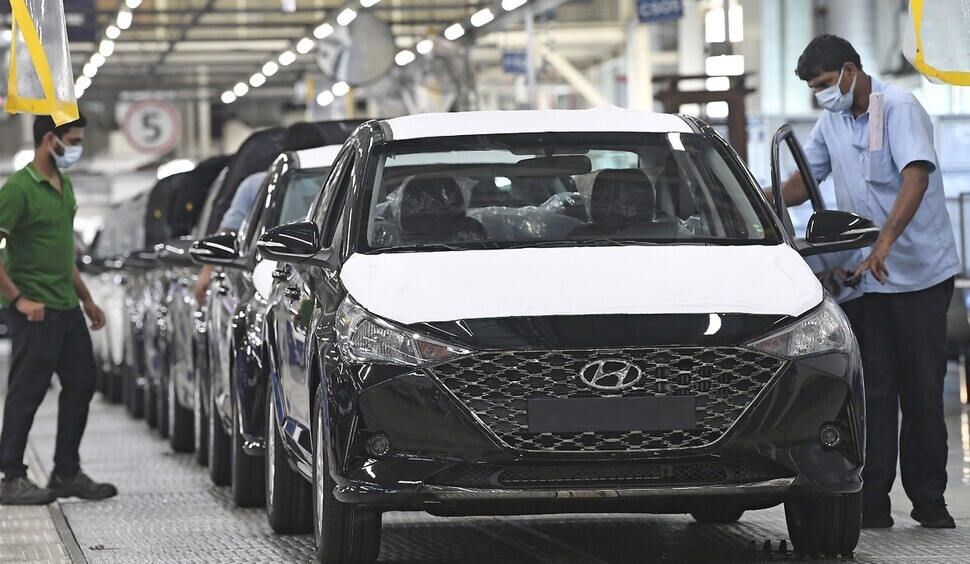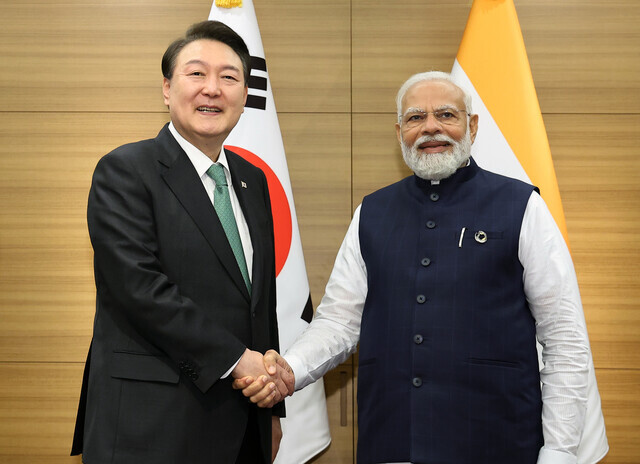hankyoreh
Links to other country sites 다른 나라 사이트 링크
In post-China era, Korean companies look to India for fresh start

“Goodbye China, make way for India?”
An employee at a major conglomerate in South Korea, Mr. Kim has noticed a change in the atmosphere whenever he visits India. Now he notices more Indians claiming that “India’s time has come” — quite a different tone from what he was hearing when landed in the South Asian country for the first time seven years ago.
In an interview with the Hankyoreh on Monday, Kim opined, “I think it’s because India’s population has overtaken that of China, and there are many people talking about more global companies investing in India.”
The number of global companies that have their eyes on India is increasing. In particular, China’s recent rivalry with the US has led to a resurgence of interest in India as a manufacturing base to replace China.
According to the United Nations Conference on Trade and Development’s (UNCTAD) World Investment Report 2022, foreign direct investment flowing into India grew from US$2.15 billion in 1995 to US$44.35 billion in 2021. In 2020, the figure soared to US$64.72 billion.
A Korean financial investment industry insider said that the volume of foreign investment in India has “increased considerably” since the beginning of the COVID-19 pandemic. “The global investment community is particularly positive about the Modi government’s efforts to attract foreign investment and create jobs through incentives such as the production-linked incentive scheme,” they said.
India’s Prime Minister Narendra Modi will make a state visit to the US this week, and is scheduled to meet with President Joe Biden on Thursday.
“Few visitors can expect the sort of welcome Narendra Modi, India’s prime minister, will receive in Washington later this month,” the British business weekly, the Economist, said in an article published on June 13.
The invitation is motivated not only by the shared goal of keeping China in check, but also by India’s growing influence on the global economy.

In February 2023, the Hana Institute of Finance revealed in a report titled “India, the New World Factory,” that foreign direct investment into India grew at an average annual rate of 11% from 2018 to 2021.
“India has emerged as an alternative, a ‘post-China’ of sorts amid the global trends of hegemonic competition between the US and China, de-globalization, and supply chain blocs,” the report read.
Behind the surge in investment in India is a US strategy to transform the country into a key location for global supply chains, such as those for hardware, software, and the automotive industry, the report said. Of course, India’s potential as a consumer market of 1.4 billion people, which surpasses even that of China, is also highly prized.
Korean companies have also recognized the growth potential of India and have steadily expanded their presence in the country over the past two decades. According to data from the Export-Import Bank of Korea, South Korea’s direct investment in India peaked at US$1.072 billion in 2018, followed by US$453 million in 2019 and US$625 million in 2020.
Hyundai Motor, which entered India in 1998 with a plant in Chennai, will invest 200 billion rupees (US$2.44 billion) over 10 years starting in 2023. The company will use the money to modernize its Chennai 1-2 plants and increase annual production to 850,000 units. It will also build a battery pack assembly plant for electric vehicles.
Sales of Hyundai’s India-produced cars have been on the upswing, with 513,000 units sold in 2020, 636,000 units in 2021 and 706,000 units in 2022. About 20% of these are exported to the Middle East and Europe with the label “Made in India.”
Combined with Kia, which entered India in 2019, Hyundai-Kia’s share of the Indian market last year was 23%, or No. 2. “India has a low vehicle ownership rate compared to its population, so there’s a lot of growth potential,” commented an automotive industry insider. “Not only that, but it also serves as a base for exporting small cars to Europe.”
Samsung completed construction of the world’s largest smartphone manufacturing plant in Noida, India, in 2018, and has since pulled out of factories in Tianjin, China, where sales have been sluggish.
Since late 2022, Samsung has also been producing its flagship models at the Noida plant. This shows that Samsung has had its sights set on India as a manufacturing base for a while now.
The president of LG Electronics, Cho Joo-wan, also visited LG’s New Delhi sales office and Noida home appliance production line on June 6. The company plans to expand its premium home appliance production capacity at its Noida and Pune plants in India.
POSCO produces automotive steel sheets through its local subsidiary POSCO Maharashtra Steel, which was established in 2009.
Despite being unsuccessful in building an integrated steel plant, POSCO operates a 1.8 million-ton-per-year cold rolling and plating plant and four processing centers in India. Since establishing its Indian subsidiary in 2018, Mirae Asset Financial Services has increased the number of retail accounts to 5.5 million as of the end of 2022.
Lessons learned from failure in Chinese marketKorean companies are focusing on how they can prevent their painful experience in the Chinese market from being repeated in India. Several major Korean companies that built large production bases in China had to discontinue operations and pull out of the market.
“Many people at the company are determined that they won’t let India go the way of the Chinese market,” said a source at the Hyundai Motor Group.
The Indian automobile market (4.76 million units sold) pulled ahead of Japan (4.2 million) last year to become the third biggest in the world.
Samsung is also taking note that Apple has entered the Indian smartphone market. Apple opened its first Apple Store in India in April and is stepping up efforts to target the local market as Taiwanese company Foxconn, a producer of iPhones and other Apple products, recently bought land for a big factory in the country.
Some say the Indian market will be a tough nut to crack. There are still infrastructural weaknesses including the labor market, roads and electricity.
“India is pushing an agenda of protecting and supporting local industries, and politicians and administrators have considerable sway,” said a source who handled imports and exports of steel and chemicals in Mumbai and Delhi from 2016 to 2021.
In other words, companies that are attracted to India’s potential should also take these serious dangers into account.
“There are numerous hurdles that Korean companies will have to clear in India because institutions and cultural mindsets there are extremely different from China or Southeast Asia. India has a shoddy manufacturing base and educational attainment varies widely, making it hard to find the right workers,” said Kim Jeong-gon, head of the India and South Asia team at the Korea Institute for International Economic Policy.
By Choi Woo-ri, staff reporter; Ko Han-sol, staff reporter; Cho Hae-yeong, staff reporter
Please direct questions or comments to [english@hani.co.kr]

Editorial・opinion
![[Editorial] Intensifying US-China rivalry means Seoul must address uncertainty with Beijing sooner than later [Editorial] Intensifying US-China rivalry means Seoul must address uncertainty with Beijing sooner than later](https://flexible.img.hani.co.kr/flexible/normal/500/300/imgdb/original/2024/0517/8117159322045222.jpg) [Editorial] Intensifying US-China rivalry means Seoul must address uncertainty with Beijing sooner than later
[Editorial] Intensifying US-China rivalry means Seoul must address uncertainty with Beijing sooner than later![[Column] When ‘fairness’ means hate and violence [Column] When ‘fairness’ means hate and violence](https://flexible.img.hani.co.kr/flexible/normal/500/300/imgdb/original/2024/0516/7417158465908824.jpg) [Column] When ‘fairness’ means hate and violence
[Column] When ‘fairness’ means hate and violence- [Editorial] Yoon must stop abusing authority to shield himself from investigation
- [Column] US troop withdrawal from Korea could be the Acheson Line all over
- [Column] How to win back readers who’ve turned to YouTube for news
- [Column] Welcome to the president’s pity party
- [Editorial] Korea must respond firmly to Japan’s attempt to usurp Line
- [Editorial] Transfers of prosecutors investigating Korea’s first lady send chilling message
- [Column] Will Seoul’s ties with Moscow really recover on their own?
- [Column] Samsung’s ‘lost decade’ and Lee Jae-yong’s mismatched chopsticks
Most viewed articles
- 1[Editorial] Transfers of prosecutors investigating Korea’s first lady send chilling message
- 2For new generation of Chinese artists, discontent is disobedience
- 3S. Korea “monitoring developments” after report of secret Chinese police station in Seoul
- 4Xi, Putin ‘oppose acts of military intimidation’ against N. Korea by US in joint statement
- 5[Photo] 1,200 prospective teachers call death of teacher “social manslaughter”
- 6[Exclusive] Unearthed memo suggests Gwangju Uprising missing may have been cremated
- 7N. Korean media upgrades epithet for leader’s daughter from “beloved” to “respected”
- 8[Column] Samsung’s ‘lost decade’ and Lee Jae-yong’s mismatched chopsticks
- 9[Editorial] Intensifying US-China rivalry means Seoul must address uncertainty with Beijing sooner t
- 10[Special reportage- part I] Elderly prostitution at Jongmyo Park